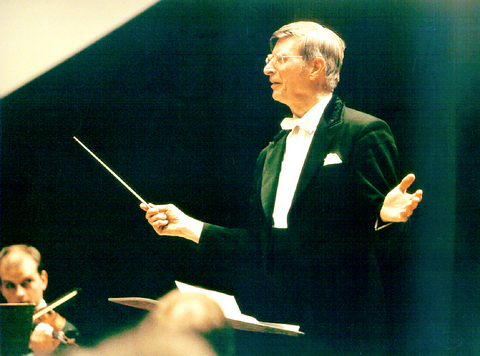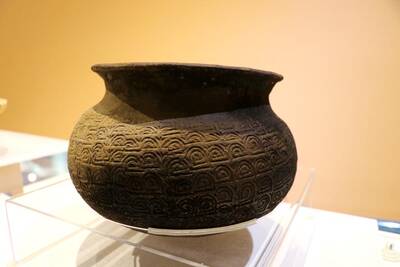Next week, Herbert Blomstedt will conduct the Leipzig Gewandhaus Orchestra when they return to Taiwan for the third time to perform at the National Concert Hall and at the Yuanlin Arts Center, Changhua County.
The orchestra will perform Felix Mendelssohn's Symphony No. 4 at both venues. Their second piece in Taipei will be Anton Bruckner's Symphony No. 7. In Changhua, the second piece will be Beethoven's Symphony No. 3.

PHOTO COURTESY OF LEIPZIG GEWANDHAUS ORCHESTRA
Blomstedt's work with the orchestra has been called the perfect match as the group travels worldwide and keeps European classical music alive.

Mendelssohn's Symphony No. 4 is commonly known as "Italian" and was first performed in 1833. The music features interpretations of street dancing, pilgrim marching and country ballads that were introduced to the composer during a stay in Italy.
Bruckner's Symphony No. 7 pulled the Austrian composer into public success when it premiered in 1884. Like his other works, the symphony combines stormy Romanticism with Classical structure and draws from folk tunes while expressing a desire and love for God and peace.
Beethoven's Symphony No. 3, called "the Eroica," is one of the greatest symphonies ever written, and marks a turning point in 19th-century musical expression. It established the symphony in its era and astonished its first audiences after it was composed in 1803 and 1804.
The Leipzig Gewandhaus Orchestra has been performing such masterpieces for 250 years and once gave premier performances of works by Mozart, Beethoven, Schubert, Mendelssohn and Brahms.
Other conductors of the orchestra besides Blomstedt have been Mendelssohn, Wilhelm Furtwaengler, Arthur Nikisch, Bruno Walter and Kurt Masur.
Blomstedt, 77, is a world-class maestro who has also collaborated with the Oslo Philharmonic, the Danish State Radio Symphony Orchestra and the Swedish Radio Symphony Orchestra.
Performance notes:
What: Leipzig Gewandhaus Orchestra
When and where: March 1, 7:30pm, National Concert Hall, 21-1 Zhongshan S Rd, Taipei (
Tickets: NT$1,200 to NT$4,200; available through http://www.artsticket.com.tw

Sept. 1 to Sept. 7 In 1899, Kozaburo Hirai became the first documented Japanese to wed a Taiwanese under colonial rule. The soldier was partly motivated by the government’s policy of assimilating the Taiwanese population through intermarriage. While his friends and family disapproved and even mocked him, the marriage endured. By 1930, when his story appeared in Tales of Virtuous Deeds in Taiwan, Hirai had settled in his wife’s rural Changhua hometown, farming the land and integrating into local society. Similarly, Aiko Fujii, who married into the prominent Wufeng Lin Family (霧峰林家) in 1927, quickly learned Hoklo (commonly known as Taiwanese) and

The low voter turnout for the referendum on Aug. 23 shows that many Taiwanese are apathetic about nuclear energy, but there are long-term energy stakes involved that the public needs to grasp Taiwan faces an energy trilemma: soaring AI-driven demand, pressure to cut carbon and reliance on fragile fuel imports. But the nuclear referendum on Aug. 23 showed how little this registered with voters, many of whom neither see the long game nor grasp the stakes. Volunteer referendum worker Vivian Chen (陳薇安) put it bluntly: “I’ve seen many people asking what they’re voting for when they arrive to vote. They cast their vote without even doing any research.” Imagine Taiwanese voters invited to a poker table. The bet looked simple — yes or no — yet most never showed. More than two-thirds of those

In the run-up to the referendum on re-opening Pingtung County’s Ma-anshan Nuclear Power Plant last month, the media inundated us with explainers. A favorite factoid of the international media, endlessly recycled, was that Taiwan has no energy reserves for a blockade, thus necessitating re-opening the nuclear plants. As presented by the Chinese-language CommonWealth Magazine, it runs: “According to the US Department of Commerce International Trade Administration, 97.73 percent of Taiwan’s energy is imported, and estimates are that Taiwan has only 11 days of reserves available in the event of a blockade.” This factoid is not an outright lie — that

The People’s Republic of China (PRC) yesterday paraded its military hardware in an effort to impress its own population, intimidate its enemies and rewrite history. As always, this was paced by a blizzard of articles and commentaries in the media, a reminder that Beijing’s lies must be accompanied by a bodyguard of lies. A typical example is this piece by Zheng Wang (汪錚) of Seton Hall in the Diplomat. “In Taiwan, 2025 also marks 80 years since the island’s return to China at the end of the war — a historical milestone largely omitted in official commemorations.” The reason for its